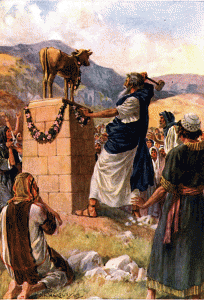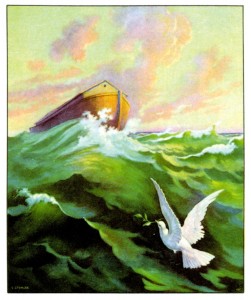Edom Has a Perpetual Hatred for Jacob (Judah and Ephraim)
As we saw in the previous blog post, Esau’s other name was Edom and he hated and tried to kill his brother Jacob (Israel). The Jewish sages over the millennia have viewed Edom as the archenemy of Israel. The biblical prophets speak of a great showdown in the end times between the literal and spiritual descendants of Jacob (the Jews and the Christians) and those of Esau (the Moslems).

Let’s explore a little further the nature of the hatred Edom has for the people of Israel.
As we have noted, Edom’s hatred for Israel has its roots in the antagonism between Ishmael and Issac, and then afterwards between Esau and Jacob. The hatred that Esau had for Israel has been passed on down to successive generations of Edomites. The biblical prophets discusses this murderous antagonism on Edom’s part as being carried down generation to generation to the very end times. Let’s review some of these biblical prophecies.
Ezekiel 36 speaks about the conflict between end-time Edom and end-time Israel. In verse two, we see that the enemies of Israel have regarded the “ancient high [or declared, promised] places” of Israel as “ours in possession.” This is a clear reference to the holy places in Israel (e.g., the Temple Mount for the Jews and Bethlehem for the Christians—only in recent years have the Palestinians taken Bethlehem and forced—out of persecution and intimidation—the majority of the large Christian population of that city to leave). “High places” can also refer to the militarily strategic high places such as the Golan Heights and the ridges surrounding the eastern shores of the Sea of Galilee.
Next, let’s look at Ezekiel 35, which is a prophecy against Edom. In verses four through five, we see that end-time Edom will be devastated because of its perpetual hatred for the Children of Israel. They have killed their enemies by the power of the sword. This is how Islam has traditionally spread—by the curved scimitar sword. Advancing Moslem armies force its captives to leave, covert or die. According to verse five, this is to be occurring at the time of the punishment (of the children of Israel?) at the time of the end (NAS) or the end of time (lit. Hebrew). This is another example of YHVH’s using Edom (Esau) to bring Ephraim and Judah to its knees in the time of the end.
In verses six through nine of the same chapter, we see that YHVH will punish Edom for its blood-thirstiness against Israel and will devastate its cities and slay large numbers of its people. Other biblical prophecies indicate that the militaries of Judah and Ephraim will be the means by which YHVH accomplishes this.
Finally, in verse 10, Edom (Islam) wants to take over or possess the two countries/nations/lands (Heb. eretz) of Israel: Judah and Ephraim even though YHVH was there (in the lands of his people). Their anger and hatred against Israel is based on envy or jealousy (verse 11) of Israel.
The Koran, the unholy book of Islam, has taken the historic and prophesied hatred of Edom and formed a religion around it. The Koran was written by Mohammed, a Jew and Christian hater, more than one thousand years after the prophecies of Ezekiel and Obadiah. Here are some quotes from the Koran that confirm the prophecies of the Bible with regard to Edom.
Make war upon those to whom the Scriptures have been given as believe not in God [Allah] … and who forbid not that which God and His Apostle [Mohammed] have forbidden, and who profess not the profession of the truth, until they pay tribute out of hand, and they be humbled. The Jews say, “Ezra in a son of God”; and the Christians say, “The Messiah is a son of God.” Such sayings in their mouths. They resemble the sayings of the infidels of old! God do battle with them! How they are misguided! (Sura 9:29–30)
When thy Lord spake unto the angels, “I will be with you: therefore stablish ye the faithful I will cast a dread into the heart of the infidels.” Strike off their heads then, and strike off from them every finger-tip. (Sura 8:12)
“O people of the Book! … Can I announce to you any retribution worse than that which awaiteth them with God? They whom God hath cursed and with whom He hath been angry—some of them hath he changed into apes and swine; and they who worship Thagout are in evil plight, and have gone far astray from the right path. (Sura 5:64–65)
Only recompense of those who war against God and His Apostle, and go about to commit disorders on the earth, shall be that they shall be slain and crucified, or have their alternate hands and feet cut off, or be banished from the land …(Sura 5:37)





 Between the time of the festival of Shavuot and Yom Teruah (the Day of the Awakening Blast) when Moses received the second tablets of stone from YHVH containing the Ten Commandments, the children of Israel, the bride of YHVH, prepared herself not only to receive YHVH’s instructions again, but this time to be faithful to her marriage vows. This Israel did. She remained faithful to YHVH for approximately 38 years while trekking through the wilderness of Sinai, after which she entered the Promised Land and “stayed the course” until after the death of Joshua.
Between the time of the festival of Shavuot and Yom Teruah (the Day of the Awakening Blast) when Moses received the second tablets of stone from YHVH containing the Ten Commandments, the children of Israel, the bride of YHVH, prepared herself not only to receive YHVH’s instructions again, but this time to be faithful to her marriage vows. This Israel did. She remained faithful to YHVH for approximately 38 years while trekking through the wilderness of Sinai, after which she entered the Promised Land and “stayed the course” until after the death of Joshua.


